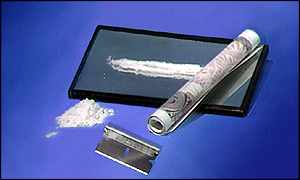Lethal Consequences
BBC
News
May 30, 2001
'One dose danger' of cocaine

Cocaine
makes the brain more responsive to addiction
The first exposure to cocaine could leave users vulnerable to addiction. Using mice for testing, scientists found that just one single use of cocaine could trigger a long-lasting surge of activity in the part of the brain linked to the development of addiction. And they said this could also be the reason why former drug users fall back into addiction after just one relapse. Drug groups are now hoping to dispel the widely held misconception that cocaine is a safer, less addictive, drug than others.
"What's so amazing is that nearly all dopamine neurons are affected by this single cocaine exposure"-Dr Mark Ungless
Addictive
A spokeswoman for Addaction said that many drug users mistakenly thought
they were safe taking cocaine as a recreational drug, but that this new study
proved this was not the case. "It is a general belief that cocaine is less
addictive and that this is assumed by users. So it is important to look at this
study." But Harry Shapiro, director of communications at the drug addiction
group DrugScope, said he would want to see more research before accepting the
findings of the research.
"Its
impossible to make sense of a condition as complicated as addiction from one study,
particularly one conducted on mice. There is little correlation between the brain
patterns of mice and humans and I would therefore be cautious about placing too
much emphasis on a single piece of research." The research, published in
Nature, showed that just one single use of cocaine doubled the responsiveness
of cells in the brain to the chemical dopamine, which produces feelings of satisfaction
and pleasure. Scientists that for up to a week or ten days after taking the drug,
the brain was more sensitize to the pleasure of taking cocaine.
The research led by a team at University of California, San Francisco's Ernest Gallo Clinic and Research Center, provides the first direct evidence that a single cocaine exposure - a recreational use - causes dramatic changes in the brain to areas that cover learning and memory. DR Antonello Bonci, senior author of the paper and assistant professor of neurology at the university said: "The study shows that the capacity for strengthening connections between nerve cells - the basis for learning and memory - can be usurped by drugs of abuse.
"The
single exposure appears to hijack the brain's normal molecular mechanisms of memory
formation for around a week." Other scientific research has shown that learning
and memory are crucially important in the development of addiction and also involve
the activation of the same brain cells - the dopamine neurons.
"Stunning"
DR Mark Ungless, lead author of the paper, said the changes they had
found in brain activity were "stunning."
"What's so amazing
is that nearly all dopamine neurons are affected by this single cocaine exposure.
"This kind of response is rare, and would have a profound effect throughout
the brain particularly other areas involved in addiction." The researchers
said the drug patterns they had found could also apply to other drugs as well
as cocaine. They now want to look into how the research can help develop treatments
for addiction.
NATIONAL
INSTITUTES OF HEALTH
Friday, April 19, 2002
Significant Deficits in
Mental Skills Observed in Toddlers Exposed to Cocaine Before Birth
A
study conducted by researchers from Case Western Reserve University in Cleveland
found that children exposed to cocaine before birth were twice as likely to have
significant delays in mental skills by age 2, compared to other toddlers with
similar backgrounds but whose mothers had not used cocaine during pregnancy. It
is probable, according to the researchers, that these cocaine-exposed children
will continue to have learning difficulties and an increased need for special
educational services when they reach school age.
The study, which was funded
by the National Institute on Drug Abuse (NIDA), is published in the April 17,
2002 issue of the Journal of the American Medical Association.
Dr.
Glen R. Hanson, Acting NIDA Director, said, "This study adds important new
evidence to a growing body of knowledge. It is the first report of a clear-cut
relationship between prenatal cocaine and mental test performance at age two.
These findings remind us of the importance of continued efforts to determine which
children and families are at risk because of exposure to cocaine, so we can prevent
or ameliorate negative consequences of using this drug."
He
added, "It is important that in this research process, we avoid inadvertently
labeling or stigmatizing large numbers of toddlers because of drug use by their
mothers during pregnancy. We want to use this type of research to help us be more
effective in how we work with these children."
The investigators followed
the developmental course of 415 infants, whose pregnant mothers were recruited
into the study at a large urban county teaching hospital between the years 1994
and 1996. All of the pregnant women recruited into the study were from high-risk
and low-socioeconomic status backgrounds. Urine samples were collected from the
women and meconium samples were collected from each baby. These samples were screened
for maternal drug use. Two hundred and eighteen infants were found to be cocaine-exposed
and 197 to be cocaine-free.
Each
infant was tested for developmental progress at 6.5, 12, and 24 months of age.
The infants were administered the Bayley Scales of Infant Mental and Motor Development,
a widely used assessment of infant development. Scores on this assessment measure
memory, language, and problem-solving abilities, as well as gross and fine motor
control and coordination.
While
no effects on the Bayley Motor Scale were detected, the cocaine-exposed children
performed more poorly on the Bayley Mental Scale than unexposed children, after
adjusting for other variables (such as use of alcohol, tobacco, or other drugs;
maternal age; prenatal care, and home environment quality). Although mental development
index scores decreased over time for both groups of infants, children prenatally
exposed to cocaine had scores that decreased faster. From 6.5 to 24 months, the
average score for infants exposed to cocaine declined by 14 points compared to
9 points for unexposed children.
Almost
14 percent of the cocaine-exposed infants had scores in the mental retardation
range, 4.89 times higher than expected in the general population. The percentage
of children with mild or greater delays was 38 percent, almost double the rate
of the non-cocaine-exposed group. Infants of mothers with evidence of higher and
more frequent cocaine use during pregnancy fared the worst.
Lead
investigator Dr. Lynn T. Singer said that there are several possible mechanisms
by which cocaine exposure during pregnancy may affect infant outcome. Developing
neural systems of the fetal brain may be directly and adversely affected by cocaine
exposure. Another possible explanation is that cocaine use during pregnancy may
constrict the vascular system, subsequently decreasing blood flow through the
placenta and resulting in low oxygen levels (hypoxemia) in the fetus.
Differences in the cocaine-exposed infants were noted at birth. These infants had lower gestational age, lower birth weight, and smaller head circumference and length than unexposed babies. There were more preterm, low birth weight and small-for-gestational age infants in the exposed group. There were 11 deaths by the time the infants were 2 years old, 8 in cocaine-positive children and 3 in cocaine-negative children. Sudden Infant Death Syndrome (SIDS) was the leading cause of death in both groups. An estimated 1 million children have been born after fetal cocaine exposure since the mid-1980's, when the so-called crack epidemic emerged with the availability of a cheap, potent, smokable form of cocaine.
NATIONAL
INSTITUTES OF HEALTH
Wednesday, May 30, 2001
New Research Shows Even
a Single Drug Exposure Can Alter Brain Function
Scientists
have found that a single use of cocaine can modify neural connections in the brain,
and this may help explain at the cellular level how occasional drug use can progress
into a compulsion. The researchers from the University of California in San Francisco
report in the May 31 issue of Nature that a single injection of cocaine induced
a long-lasting (between 5 and 10 days) increase in excitatory synaptic transmission
in the ventral tegmental area of the brain in rats and mice. The increase in synaptic
currents that were activated by cocaine had many similarities to the changes in
neural activity involved in learning and memory processes in many areas of the
brain.
"These findings on the impact of cocaine on the memory and learning circuits of the brain may help explain the switch from occasional drug use to addiction. This study emphasizes the dangers of even experimenting with cocaine and other illicit drugs," says Alan I. Leshner, Ph.D., Director of the National Institute on Drug Abuse (NIDA). "The significance of this finding," says lead investigator Dr. Antonello Bonci, "is that the single dose of cocaine 'usurped' a cellular mechanism involved in a normally adaptive learning process, which may help to explain cocaine's ability to take control of incentive-motivational systems in the brain and produce compulsive drug-seeking behavior." In addition, the researchers said that the changes that were observed in the brains of the rats and mice may be important not just for the early stages of addiction, but also may help explain the neural basis for relapse, where a single exposure to cocaine after a period of abstinence can induce renewed drug-seeking behavior.



